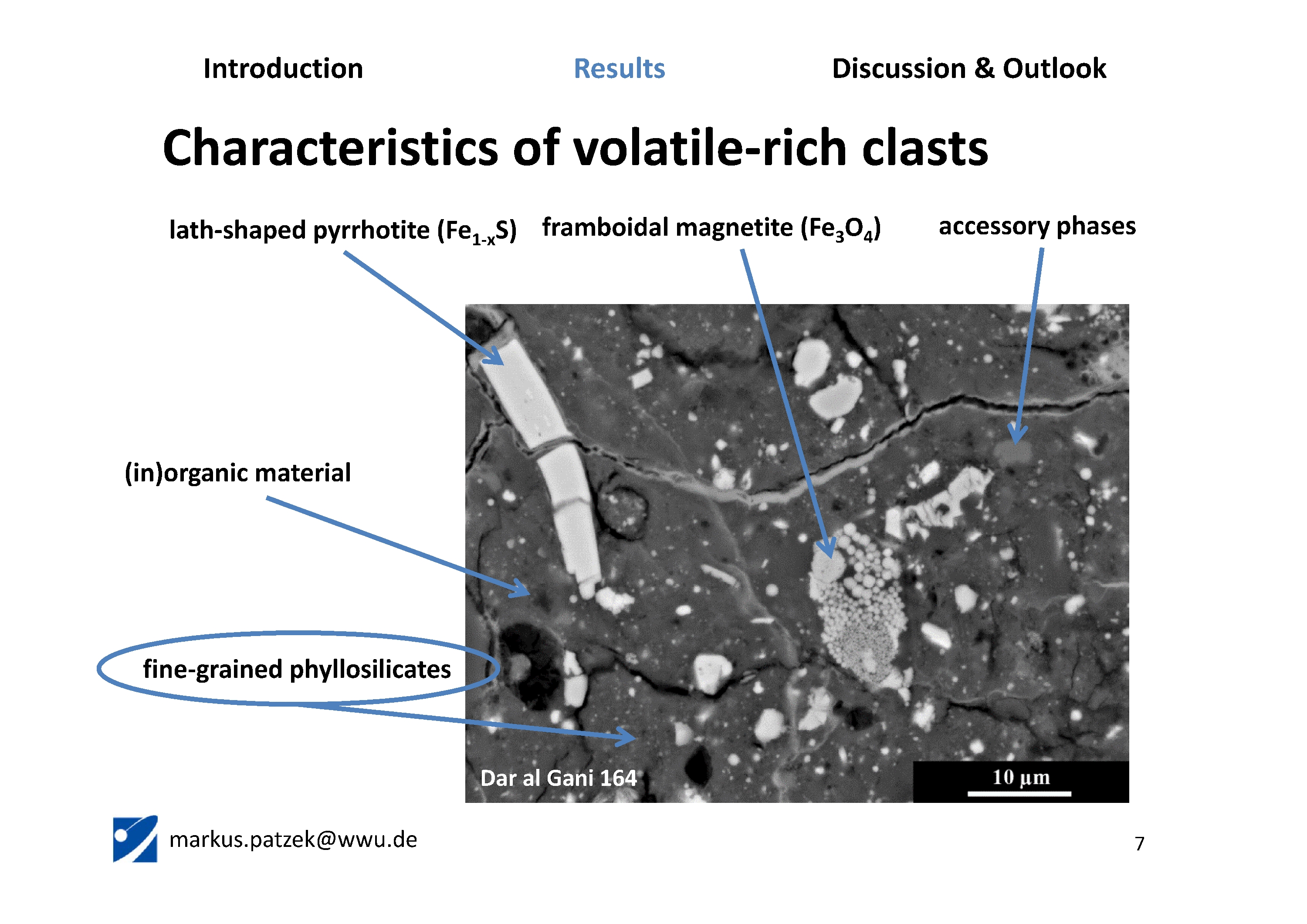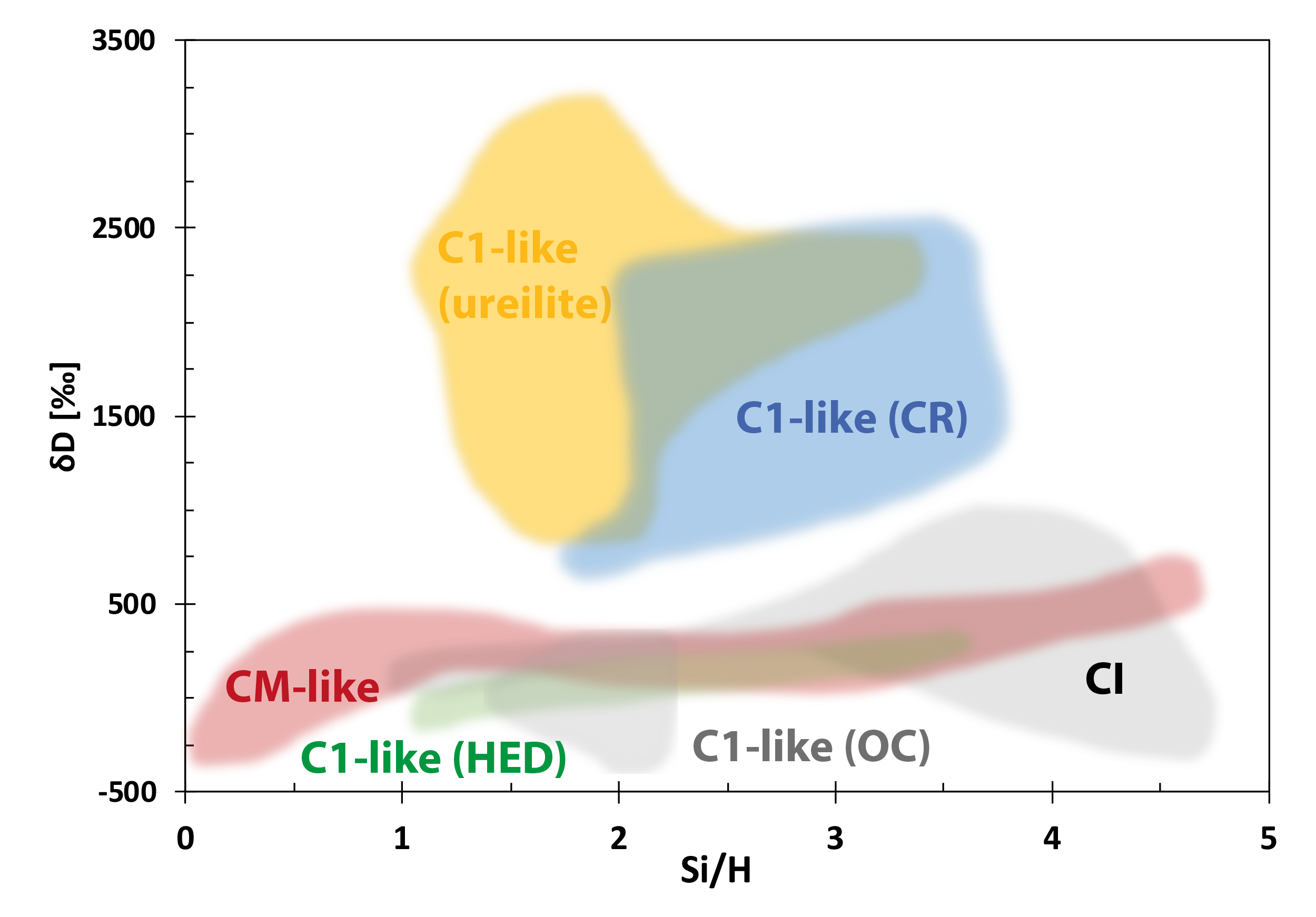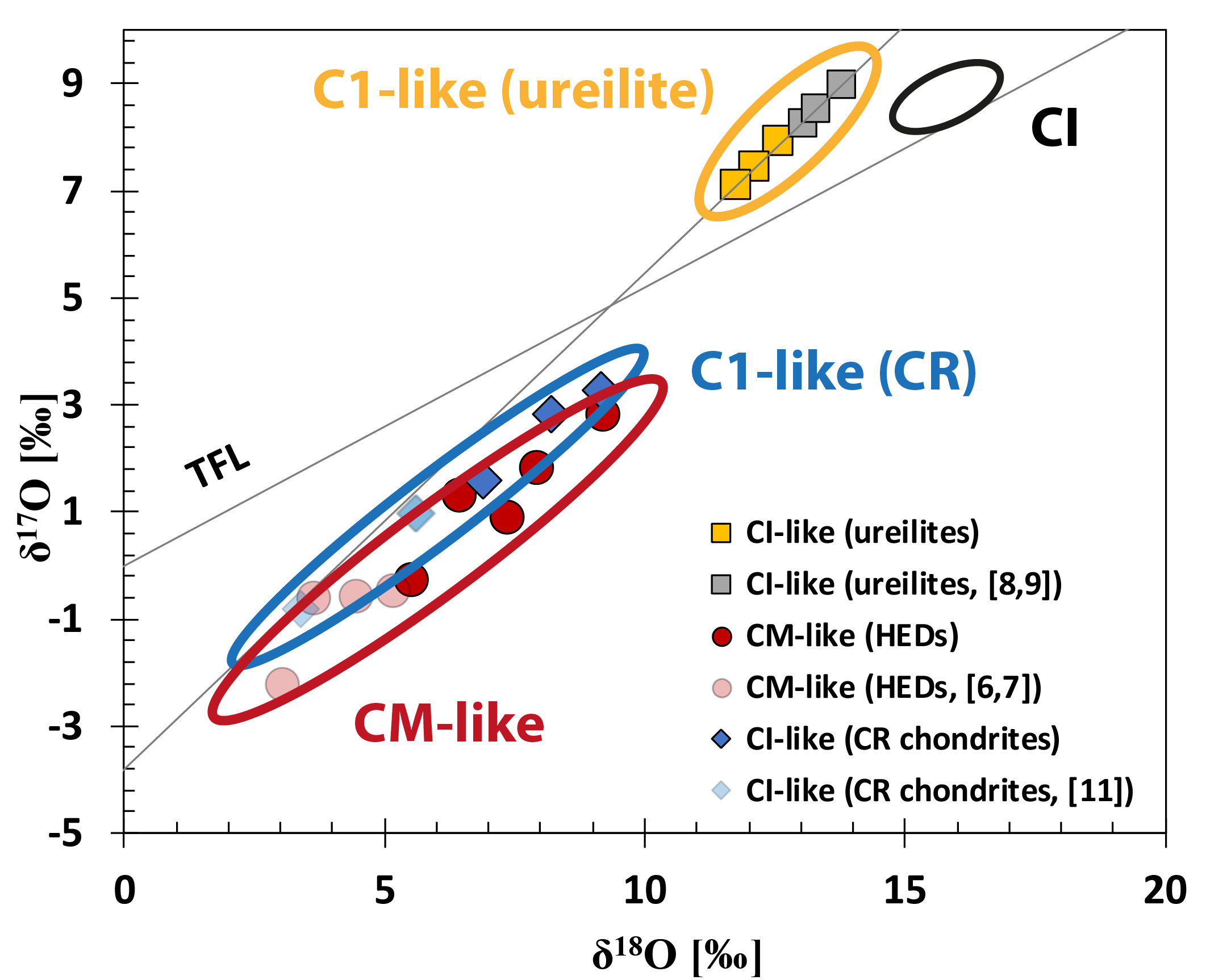Understanding the origin of the highly volatile component in planetary bodies is of fundamental importance in order to decipher key processes in terrestrial planet formation, such as where Earth’s water came from. The source of these volatiles is either in the building blocks of the planets or in the material that was added onto the Earth during late accretion. Volatile-rich materials may have been scattered into the solar system as a consequence of giant planet migration, during which volatile-rich objects were transported inward from
beyond the snow line where water ice was stable.
Today, we can find volatile-rich material as xenolithic fragments in various types of meteorites providing us with the possibly to decipher their chemical and isotopic characteristics without the effect of billion of years of geologic processes.
We study major, minor and trace elements of these xenolithic, volatile-rich clasts using various techniques including scanning electron microscopy, electron microprobe analysis and Laser Ablation ICP MS. In-situ determination of various isotope system (e.g. H, O and S) are done by using secondary ion mass spectrometry (SIMS and nanoSIMS; cooperation with Heidelberg, nordSIM Stockholm and MPI Mainz). Bulk isotope determination (O, N and noble gases; cooperation with University of Göttingen, CRPG Nancy) will also be determined by various mass spectrometic techniques. By combining all findings we will be able to shed light on the origin of these clasts and their genetic link to other volatile-rich material. Finally, we may be able to evaluate the importance of this material with regard to its impact on the volatile inventory of todays Earth.




2019
Alfing, J., Patzek, M., Bischoff, A., 2019: Modal abundances of coarse-grained (>5 µm) components within CI-chondrites and their individual clasts – Mixing of various lithologies on the CI parent body(ies). Geochemistry. 10.1016/j.chemer.2019.08.004
Bischoff, A., Barrat, J.-A., Berndt, J., Borovicka, J., Burkhardt, C., Busemann, H., Hakenmüller, J., Heinlein, D., Hertzog, J., Kaiser, J., Maden, C., Meier, M. M. M., Morino, P., Pack, A., Patzek, M., Reitze, M. P., Rüfenacht, M., Schmitt-Kopplin, P., Schönbächler, M., Spurny, P., Weber, I., Wimmer, K., Zikmund, T., 2019: The Renchen L5-6 chondrite breccia – The first confirmed meteorite fall from Baden-Württemberg (Germany). Geochemistry. doi.org/10.1016/j.chemer.2019.07.007
Kerraouch, I., Ebert, S., Patzek, M., Bischoff, A., Zolensky, M. E., Pack, A., Schmitt-Kopplin, P., Belhai, D., Bendaoud, A., Le, L., 2019: A light, chondritic xenolith in the Murchison (CM) chondrite – Formation by fluid-assisted percolation during metasomatism? Geochemistry. 10.1016/j.chemer.2019.06.002
Visser, R., John, T., Patzek, M., Bischoff, A., Whitehouse, M. J., 2019: Sulfur isotope study of sulfides in CI, CM, C2ung chondrites and volatile-rich clasts – Evidence for different generations and reservoirs of sulfide formation. Geochimica et Cosmochimica Acta, Vol. 261, pp. 210-223. 10.1016/j.gca.2019.06.046
Haack, H., Sørensen, A. N., Bischoff, A., Patzek, M., Barrat, J.-A., Midtskoge, S., Stempels, E., Laubenstein, M., Greenwood, R., Schmitt-Kopplin, P., Busemann, H., Maden, C., Bauer, K., Morino, P., Schönbächler, M., Voss, P., Dahl-Jensen, T., 2019: Ejby - A new H5/6 ordinary chondrite fall in Copenhagen, Denmark. Meteoritics and Planetary Science, Vol. 54, pp. 1853-1869. 10.1111/maps.13344
2018
Bischoff, A., Schleiting, M., Patzek, M., 2018: Shock stage distribution of 2280 ordinary chondrites – Can bulk chondrites with a shock stage of S6 exist as individual rocks? Meteoritics and Planetary Science. 10.1111/maps.13208
Visser, R., John, T., Menneken, M., Patzek, M., Bischoff, A., 2018: Temperature constraints by Raman spectroscopy of organic matter in volatile-rich clasts and carbonaceous chondrites. Geochimica et Cosmochimica Acta, Vol. 241, pp. 38-55. 10.1016/j.gca.2018.08.037
Bischoff, A., Schleiting, M., Wieler, R., Patzek, M., 2018: Brecciation among 2280 ordinary chondrites – Constraints on the evolution of their parent bodies. Geochimica et Cosmochimica Acta, Vol. 238, pp. 516-541. 10.1016/j.gca.2018.07.020
Patzek M., Visser R., Bischoff A., John T. (2018): Mineralogy of volatile-rich clasts in brecciated meteorites. Meteoritics & Planetary Science, Vol. 53, pp. 2519-2540. 10.1111/maps.13175
2017
Morlok, A., Bischoff, A., Patzek, M., Sohn, M., Hiesinger, H., 2017: Chelyabinsk - a rock with many different (stony) faces: An infrared study. Icarus, Vol. 284, pp. 431-442. 10.1016/j.icarus.2016.11.030
List of publications can be found on WWU Webpage.


